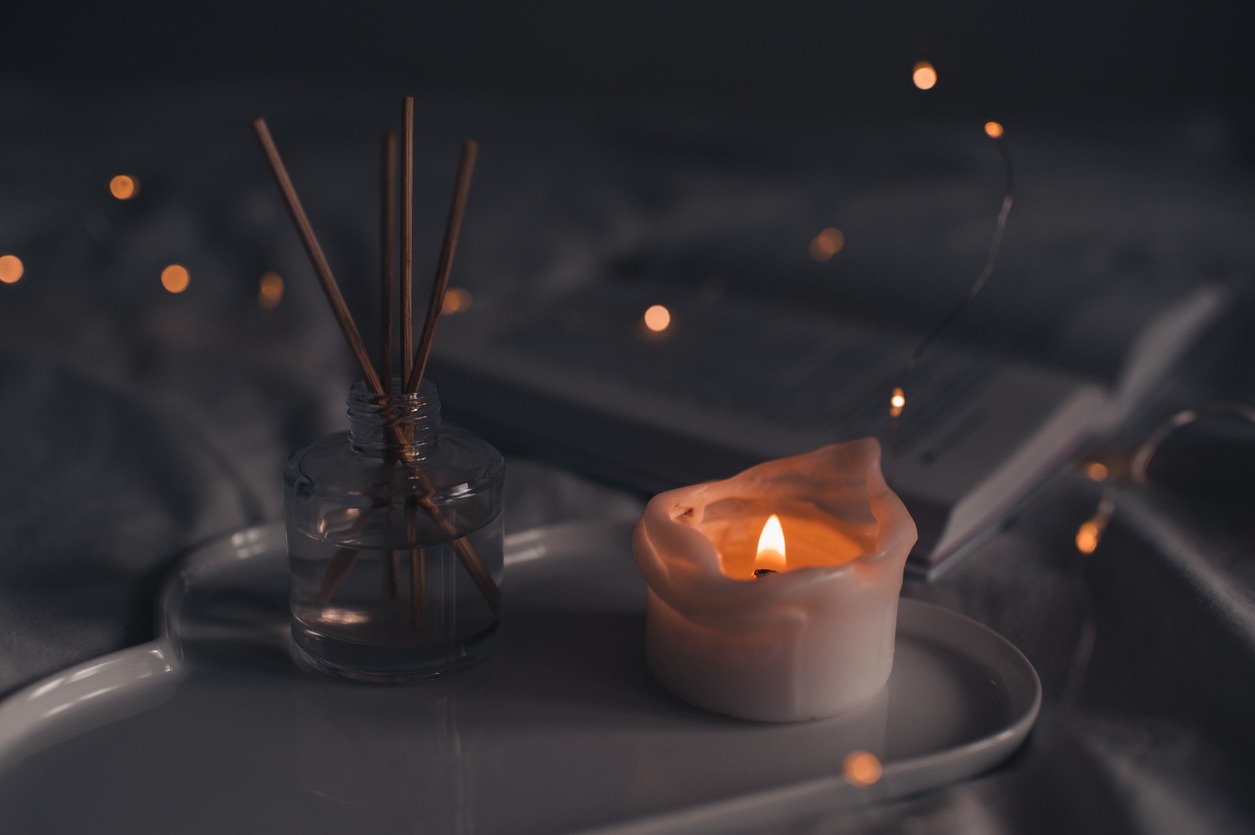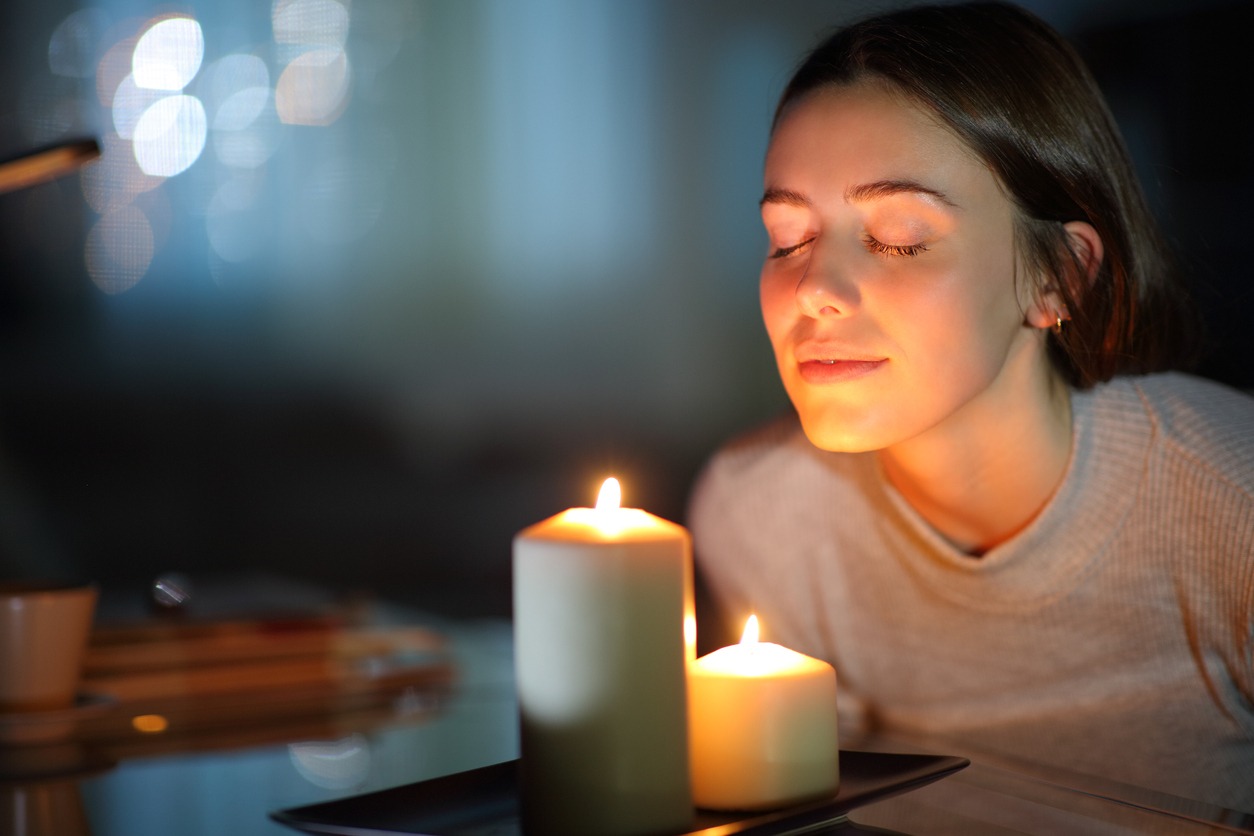Candles undoubtedly offer a pleasant and relaxing mood. It also helps add warmth to your room. But since it’s an open flame, maintaining safe candle-burning practices is essential for your safety and health.
If you love scented candles, you probably love to wind down for the evening with candles giving you a relaxing ambiance as you head to bed. You may want to carry on this ambiance as you close your eyes and fall asleep – after all, it’s comforting, the light is just enough to sleep with, and the scent is relaxing.
But is it safe to sleep with a lighted candle? No, it isn’t! Learn about how candles, especially specific scents, can help you with sleep problems and why you must blow them out before falling asleep.
Can Candles Help you Sleep?
For some people, candles help put them in a sleepy mood. First of all, the light of the candle is visually relaxing. The dim light and the dance of the candle flame evoke feelings of calm. And since the light is not too bright, it helps the brain relax.
In addition, the scent of a candle can be very relaxing. Candles that help with sleep include scented candles and therapy candles with different scent options that are meant to relax and help you get to sleep. It can be used at any time of the day, but it’s preferable to use it at night, just before going to bed.
Certain chemicals react when your brain registers the smells, causing calming mental and physical effects. The relaxing effects of scents can be traced in the organs involved in the olfactory system, which is responsible for our sense of smell.
Humans have sensory neurons at the back of the nasal cavity called olfactory receptor cells. Each of them has tiny hair-like structures that use receptor proteins to bind aroma compounds. When the binding happens, a chemical stimulus transmits information from the neurons to the olfactory bulb in the brain.
The olfactory bulb is part of the limbic system, which performs several functions, including behavior, emotion, and long-term memory. So, whenever a certain scent makes you nostalgic, relaxed, or noticeably emotionally soothing, it’s because of the involvement of the limbic system.
This may also trigger your good dreams when you fall asleep. And if you want to remember your good dreams, write them in a dream journal when you wake up.
Candle Scents to Aid in Sleep
Soothing scents can help reduce stress and aid in insomnia, which can lead to a good night’s sleep. Here are some scents that can help with insomnia:
1. Lavender
We have all heard about how lavender is a calming scent. This is why lavender oils, lavender drops for pillows, and lavender-scented eye masks are popular. If you tried these and still can’t help you sleep, you may want to try lavender candles.
Lavender calms and relieves anxiety by slowing down the nervous system. You feel more ready to let go and fall asleep as your body relaxes.
2. Rose
Rose has a lot of great properties, and it’s believed to have sedative effects that can help you feel nice and cozy before bed. The smell of rose can trigger the brain’s emotional and behavioral control centers. It does not only help you sleep better – it can also lead to happier and sweeter dreams.
3. Jasmine
The smell of jasmine is known to help calm the body and relax nerves. Jasmine is a fantastic sleep aid (including jasmine tea), which can help you drift off more easily. It’s also great for anyone with restless leg syndrome, as your muscles relax before falling asleep. The aroma of jasmine flowers has been used to fight insomnia for centuries.
4. Chamomile
When it comes to nighttime teas, chamomile is a favorite because of its calming properties. Coupling this tea with a chamomile candle can be a perfect way to enjoy a decent night’s sleep. It encourages calm and relaxation for the body while helping relieve stress and tension. Chamomile has a mild and lovely scent, making it great for anyone who can’t stand overly strong or cloyingly sweet aromas.
5. Sandalwood
Sandalwood offers a fairly sweet scent that can help you feel calm, helping you fall asleep. This scent encourages the body to wind down and get ready to sleep. It also helps you stay in a pre-REM sleep longer than your usual cycle.
6. Cedarwood
Warm scents like cedarwood can help you relax, as it is often used to help the nervous system fight stress and anxiety. The spicy, woody aroma of cedarwood can help fight feelings of tension and ease your struggling to wind down. It’s believed to encourage undisturbed sleep.
Why is it Important to Extinguish Candles before Sleep?
Forgetting to blow out your candles before sleep is scary. It may not seem like a big deal at first, but it’s vital to follow proper safety protocols if you don’t want serious consequences to happen. Many things can go wrong and result in irreversible damage. Here are some of the risks and potential hazards of burning a candle all night.
1. Candles can be knocked over
What if you or a family member wake up suddenly at night to go to the bathroom, and they’re too sleepy to check if they’re walking in a clear spot? They might knock over a candle on their way, causing fire or injury.
Even if you live alone, there’s still a risk of this happening. A blowing curtain or direct wind can knock a candle over if it’s lit near a window. If you have a pet, it might be responsible for it.
Also, natural disasters like earthquakes or tornados can happen in the middle of the night, rattling your shelves and furniture just enough to shake the candle off. Though it might be unlikely, it happens more often than you think, bringing a high price to pay for a bit of relaxation and ambiance.
2. Nearby objects can catch fire
Curtains, flowers in a vase, plants, clothing, wood, lampshades – these are just a few of the things that can always seem to be drawn like a moth to the flame. Even if you do your absolute best to keep your candle away from flammable items, anything may happen while you’re asleep and cause the flame to come in contact with a flammable object.
3. Candles can be toxic
Some candle waxes can be toxic because they release harmful substances and chemicals into the air as they burn. Like scented candles and those made of paraffin, some candles release chemicals that can lead to indoor air pollution. When you stay in this place for a long period, prolonged exposure can cause respiratory system problems. If the room is unventilated, the risk is even higher.
It’s even possible to contract carbon monoxide poisoning if you’re burning candles in unventilated rooms for longer than the recommended length of time. It’s not a good idea to increase the amount of time you’re exposed to these candles. Fresh air is still the best.
4. Candles can fill your room with soot
If you sleep with a candle, it may burn so long that carbon builds up on the wick, causing it to become disfigured or mushroomed. This makes the flame distorted, and this kind of flame produces soot and smoke.
The soot and smoke can leave black spots on your walls, curtains, and ceilings, and it’s dangerous if it’s inhaled and has entered the lungs.
5. Glass can break
A popular material for a candle holder is glass. While glass isn’t precisely flammable, it can crack or shatter under temperatures higher than a particular threshold. If it burns long enough or reaches all the way down to the bottom, it may create an atmosphere hot enough for the glass to break. In this scenario, the jar can break or burst, let out the fire, and start a potential hazard. Also, if the glass bursts from the heat, the shards can go in all directions, causing injury.
6. Wax can leak
If the glass happens to break, one of the consequences is dripping melted wax. Though it’s not likely to cause a fire once it spills out, the wax can stain or burn the surfaces underneath it. Once it hardens, it can be difficult to remove, like in a carpet, rug, or tablecloth.
7. There’s a chance of candle flashover or secondary ignition
When melted wax catches flame from the burning wick, it can cause a quick flutter, and a small blaze of fire can start within seconds. If you’re awake, this type of fire can be extinguished, but when you’re asleep, this small blaze can spread and increase by several folds, leading to flames spreading to nearby objects.
How to Burn Candles Safely
If you are fond of lighting scented candles, do it right by doing the right things and taking precautionary measures.
- Place the burning candle on a stable surface to prevent it from being knocked over.
- Make sure the candle is at a significant distance away from the curtains and windows.
- Keep the candle isolated and away from anything – flammable or not. This will help prevent any secondary fires or damage to your other objects that might be affected when put near a hot flame.
- Make sure the room is ventilated before lighting a candle.
- Read the manufacturer’s label and safety instructions before using it. The candle maker usually offers advice on a recommended burning time and sticks to it.
- Do not leave a candle burning unattended or kept within reach of pets, small children, and drafts.
- Never burn a candle for less than an hour and no longer than four hours.
- Wicks that are crooked or too long will cause the candle to burn unevenly or emit soot. It helps if you trim the wick first to ¼ inch in length.
- Trim the wick after every use to at least ¼ of an inch.
- Extinguish the flame by snuffing it rather than blowing on it.
- When the candle cools, put the lid back on.
- You always need to ensure that you burn candles safely. In case of touching the fire and causing burns on your skin, the Best Ointments and Creams for Burns may help.



